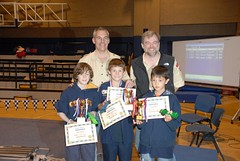Team Leadership
 Lencioni (2002) paints a wonderful picture of the development of teams that captures a valid representation of team renewal that also serves as a reflection on the key components of ongoing team development.
Lencioni (2002) paints a wonderful picture of the development of teams that captures a valid representation of team renewal that also serves as a reflection on the key components of ongoing team development.
At the foundation and consistent with my own beliefs is the critical need for trust at the base of a team’s pyramid. But, as Lencioni points out, these layers of concerns must be seen as interrelated in order to get at the core of team development. Trust, by itself, is insufficient for achieving the kind of team dynamics that result in accomplishment beyond expectations, which serves as the definition of a high functioning team.
The purpose of this blog entry is not to recount all aspects of this model of team assessment. In my own recent experience I have been involved in two ways with teams that provide diametrically opposite examples of teams at their best and worst.
As a member of a larger logistical team, I have been both frustrated and frustrating because of an absence of the foundational trust aspect that is required for team development. While I value that I have a role to play in this team’s success or lack thereof, it seems outside my power and control to initiate actions aimed at resolving deficiencies at multiple layers of the pyramid. At the core, this team has little trust due to a top-down management style that is inherently paranoid. With many demonstrations of a sincere lack of trust, it is clear that what follows is a general fear of conflict and a generative focus on individual well-being. Thus, few members of the team have the ability to commit to the team and half of the team has tendered their resignation. This act of exasperation is the ultimate demonstration of avoidance and, by virtue of this, despite commitments to the contrary, there is no clear indication that results are in anyone’s conscious focus.
Interestingly, however, I also serve as a leader on a more local team that is one step removed from the higher leadership team. Similar to Lencioni’s example, this departmental team is functioning well within its own context. As a leader of this team, trust was a critical component of our initial stages of development. As noted in another text, Katzenbach & Smith (1993) define a leadership style that is effective at addressing the team strategies denoted by Lencioni. Development of trust is often associated with a leadership attitude that inspires team members. Leaders must often be seen as vulnerable in order to illicit contributions from other members that develop out of concern for the well-being of the team and organization — and each other. Thus, this focus satisfies three areas of the triangle – trust, commitment, and results. Accountability and conflict emerge in the processes once team members are engaged. Thus, we get a self-perpetuating cycle of commitment and accountability.
As Katzenbach & Smith point out, each team is unique in defining the skills needed to lead. While in one instance, a leadership style applied as highly management oriented fails, in another example, honest servant leadership leads to distinct gains. This should not be used as an argument for a more lenient leadership style. Quite the contrary, this is just a cautionary tale that reinforces the fact that each team of experience needs to be uniquely addressed as to its respective strengths and weaknesses. The dynamics of team development continue to emerge as unique and interesting in the realm of leadership research.

